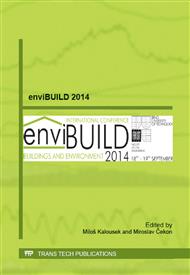p.243
p.247
p.253
p.257
p.261
p.265
p.269
p.273
p.277
The Presence of Microscopic Algae and Funguses on the Facades of Buildings Equipped with Thermal Insulation Composite System (ETICS)
Abstract:
In the last decade we have been confronted with problems with biotic infestation of facades in engineering practice. The presence of microscopic algae and funguses on the facades of thermal insulation buildings distorts the appearance of buildings with green, brown or black coating. The reason for biotic pests beginning to appear on the facades of buildings very often is mainly the enlargement of thickness of thermal insulator ETICS. Thanks to the thermal insulation of facades with large thickness less thermal energy penetrates into the surface or plaster surface. The outer side is warmed up less and therefore it has lower outer surface temperature. Lower outer surface temperatures enable hypothermia of the surface of facades. The hypothermia of facades appears especially at night. The resulting aqueous film is the basic source of the necessary damp needed for the life of algae and funguses on facades of buildings. The presence of damp on the outer surfaces rises significantly depending on the better thermal insulation of walls.
Info:
Periodical:
Pages:
261-264
Citation:
Online since:
October 2014
Keywords:
Price:
Сopyright:
© 2014 Trans Tech Publications Ltd. All Rights Reserved
Share:
Citation:


